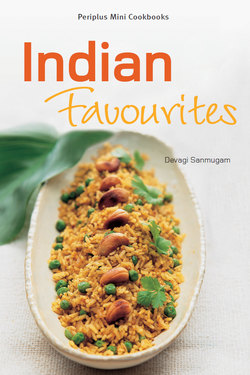Читать книгу Indian Favourites - Sanmugam - Страница 4
ОглавлениеBasic Indian Ingredients
Ajwain seeds are small, brown seeds with a flavour similar to thyme. Substitute cumin or caraway seeds.
Asafoetida is a pungent gum usually sold in dried powder form. It is added in small quantities to dishes such as Dal Fritters and Okra in Yogurt Sauce. Store in a well-sealed container.
Basmati rice is an Indian rice with a characteristic thinness and fragrance. The grains remain whole and separate when cooked with oil and spices. Available in Indian food stores.
Caraway seeds are oblong seeds that are light brown in colour and have a nutty, delicate anise flavour.
Cardamom pods, black or green, are highly aromatic. They are rough on the outside and contains tiny black seeds inside. If whole pods are used, they should be removed from food before serving. If seeds are called for, lightly smash the pods and remove the seeds, discarding the pod. Ground cardamom powder is sold in packets or small tins.
Coconut cream and coconut milk are available canned and in packets in supermarkets. In general, add 1 cup of water to 1 cup of coconut cream to obtain thick milk, and 2 cups of water to 1 cup of coconut cream to obtain thin coconut milk.
Coriander is the most common herb used in Asian cooking. The whole plant is used. Coriander leaves are often used as a garnish. They are usually sold in bunches with the roots attached. Dried round and beige coriander seeds are perhaps one of the most widely used spice in Indian dishes. When ground, they release a warm, nutty, slightly citrus-like aroma. Whole coriander seeds have a stronger flavor than ground coriander powder, which quickly loses its aroma.
Cumin seeds are pale brown to black in colour and are usually combined with coriander seeds in basic spice mixes. They are often dry-roasted or lightly stir-fried in oil to intensify their flavour, which is often likened to liquorice.
Chillies come in many sizes. Fresh green and red finger-length chillies are moderately hot. Tiny red, green or orange chili padi (bird’s eye chillies) are very hot. Dried chillies are usually deseeded, cut into lengths and soaked in warm water to soften before use. Chilli powder is made from ground dried chillies.
Curry leaves are sold in sprigs containing small, green leaves with a distinct fragrance and flavour. Available in Indian stores.
Curry powder is a commercial blend of spices that varies greatly in colour and flavour from brand to brand. Different blends are available for meat, fish or chicken dishes. Use an all-purpose blend if a specific curry powder is not available.
Fennel seeds are larger and paler than cumin seeds, with a sweet flavour similar to that of anise.
Fenugreek seeds are small, flat and slightly squarish, with a deep furrow in the middle. They are bitter, so use sparingly.
Garam masala is a blend of powdered salt, cinnamon, cardamom, cloves, fennel and black pepper. Store in an airtight container.
Dal refers to a variety of dried split peas and beans. Channa dal resembles yellow split peas but smaller. Substitute yellow split peas. Channa dal is also ground to make channa flour . Tur dal is a pale yellow lentil which is smaller than channa dal. Urad dal can be either white (husked) or black (unhusked). Mung dal are small, flat yellow beans that do not need to be soaked before cooking. Dried mango powder (amchur) adds a distinctive fruity sourness to Indian dishes. Substitute lime juice or green mango juice.
Ghee is clarified butter oil with milk solids removed. It is widely used in Indian cooking. Sold in small cans in Indian food stores and supermarkets. Substitute butter or vegetable oil.
Mustard seeds are small, brownish-black seeds that are usually fried in hot oil before adding other ingredients to impart an almost nutty flavour to the dish.
Rose water or rose essence imparts a delicate sweetness and fragrance to desserts and drinks. If using rose essence rather than rose water, reduce the amount called for in the recipe. Saffron strands impart a subtle flavour and intense yellow colour to foods. They should first be soaked in water or milk for 5 minutes, then strained or added to dishes whole. Use sparingly.
Tamarind imparts a fruity sourness to dishes. To make tamarind juice, mash about 1 tablespoon of tamarind pulp in 2 tablespoons of warm water, squeeze and strain to remove and discard the seeds and fibres.
Turmeric is a root that looks almost like ginger, but has a bright yellow flesh and a pungent flavour. It is sold fresh or as a yellow powder that has a milder flavour.
